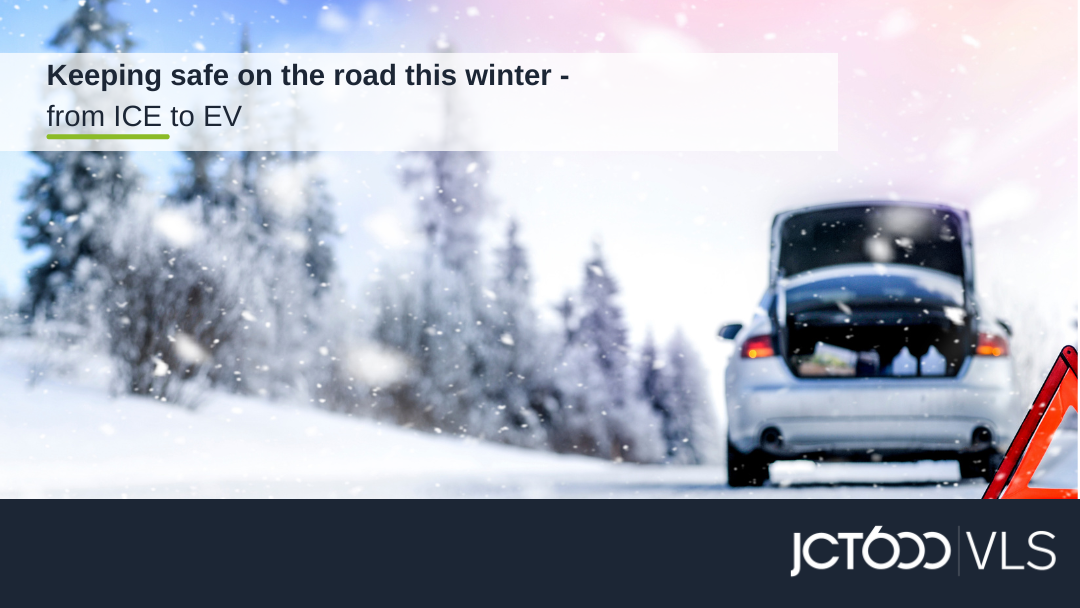As the UK has been hit by snow and ice, we want to give your drivers some helpful hints to keep safe on the roads this winter, as well as top tips if they’ve got an electric vehicle.
The colder months can mean more hazardous driving conditions and additional checks required to keep your vehicle running safely. Avoid any potential weather-related accidents with our Plan, Prepare, Drive tips. Whilst some of these may seem obvious, it’s often the simplest of actions that can make a significant difference. Here we lay out a series of tips to stay safe on the road.
Driving in colder conditions requires more consideration, but what if you have an electric vehicle (EV)? How will the snow and ice affect your car? Don’t worry, we’ve got you covered…
The main thing you need to be aware of is how the cold weather could impact the battery life and efficiency. You’re likely to get fewer miles out of it than usual, the AFP suggests that it is
“wise to consider the likely maximum daily mileage without charging as being 25-30% less than the range quoted by the manufacturer. Many manufacturers now put on their websites range calculators so you can look at the impact of weather, speed and air conditioning etc, on the range of the vehicle.”
However, with careful planning, this doesn’t need to be an issue. Here are some top tips on how to get the most from your EV’s battery this winter:
Drive efficiently – Be aware of how you drive to conserve vital battery life by driving at a steady speed, avoid sudden acceleration and braking; and consider minimising your use of radios and heaters.
Use eco-mode – If your vehicle has an ‘eco-mode’ then make use of it to get more miles out of your battery. It is designed to focus battery power where needed and away from features such as heaters and speakers. You can also try to use heated seats and steering wheels rather than the heater to add range.
Keep it covered – The warmer your battery is, the more likely it is to hold its charge. Try keep your EV in a garage if possible or cover it with a blanket if not.
- Preheat the car and battery – The majority of today’s electric vehicles have a preconditioning feature, which enables the car to warm up while it’s still plugged in – therefore not using the battery life to heat the car. Some vehicles may also allow you to do this remotely via an app or timer.
- Regenerative braking – Many EVs and PHEVs use regenerative braking; this is where the electric motor acts as a generator and sends energy back to the battery, keeping you topped up. For it to work effectively, the car needs to be warm for the battery to capture the extra energy – preconditioning can help with this. If your car has a Winter/Snow mode use this. Strong regeneration can upset the car on a slippery surface. If this isn’t available, try not to use more than Level 1.
Other considerations for your EV this winter:
- Charging times – in cold weather, it may take extra time for the battery to fully charge.
Driving in snow – EVs are built different to their ICE counterparts. The battery is often located underneath the car, giving a lower centre of gravity, and giving electric cars better traction, especially when crawling through snow. Many EVs also include features such as stability control and anti-lock braking, further supporting handling and traction by monitoring speed, reducing wheel-spin and activating the brakes for you. - Driving on ice – EVs tend to be heavier than ICE vehicles, making it harder to bring the car back under control. If you need to drive in icy conditions, it’s important to drive slowly. Consider winter tyres to improve grip and reduce the risk of sliding.
Looking after an electric vehicle during the winter months is similar to how you would have performed your winter checks on a petrol or diesel car, however, being aware of these extra tips will help keep drivers safe this winter and reduce downtime.

